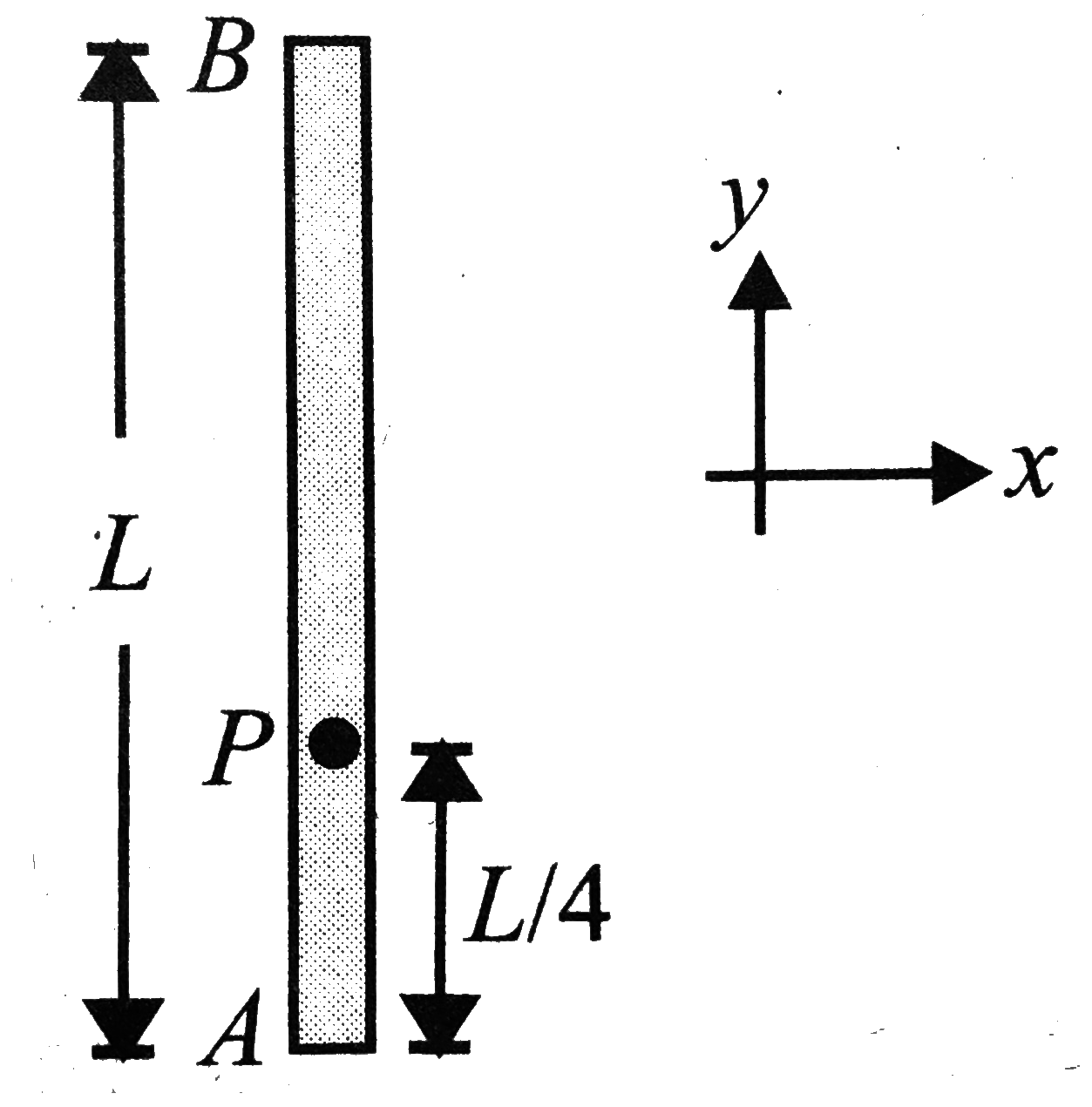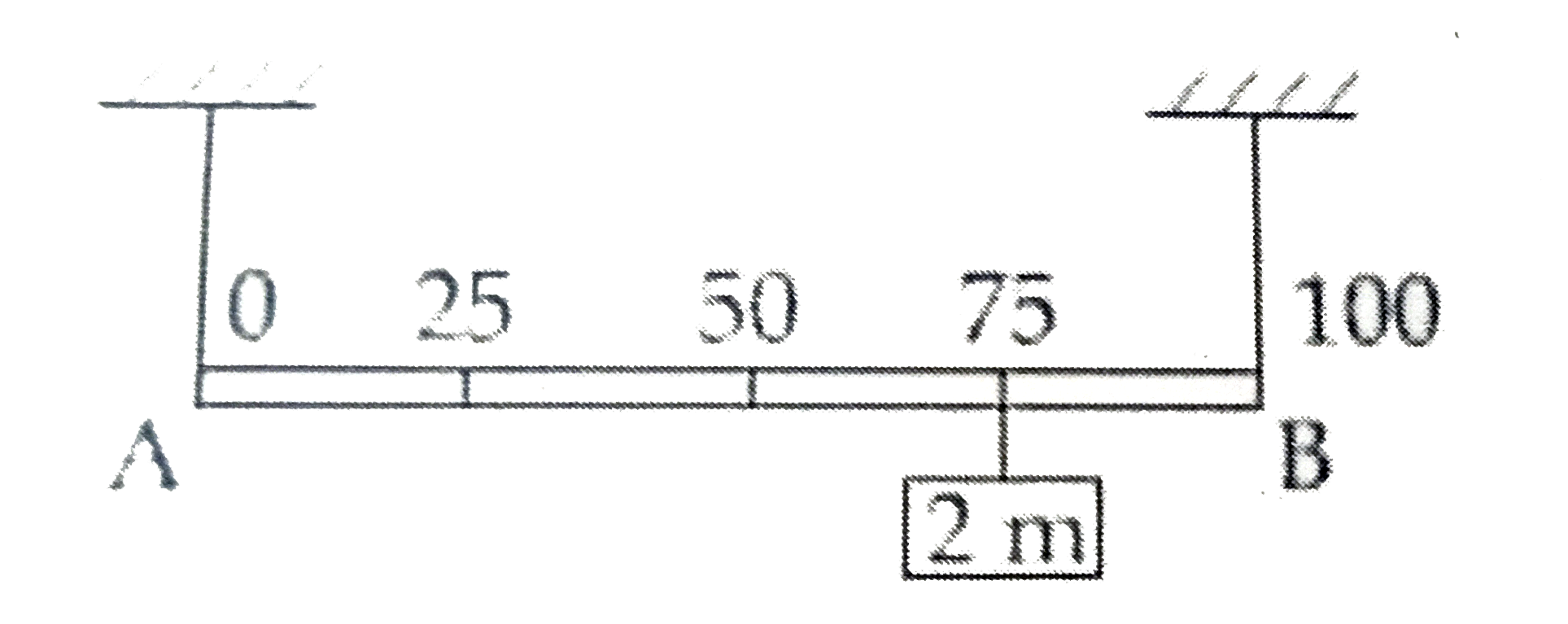A rod of weight w is supported by two parallel knife edges A and B and is in equilibrium in a horizontal position. The knives are at a distance d from each other. The centre of mass of the rod is at distance x from A. The normal reaction on A is.. And on B is......
wxd
wdx
w(d−x)x
w(d−x)d
To solve the problem, we need to find the normal reactions on the knife edges A and B when a rod of weight W is supported by them. The rod is in equilibrium, and we will use the principles of static equilibrium and torque balance to derive the required expressions.
1. Identify the Forces:
- Let N1 be the normal reaction at knife edge A.
- Let N2 be the normal reaction at knife edge B.
- The weight of the rod is W.
2. Apply the Equilibrium Condition:
- Since the rod is in vertical equilibrium, the sum of the vertical forces must equal zero:
N1+N2=W(Equation 1)
3. Torque Balance:
- We will take moments about the center of mass of the rod. The distance from A to the center of mass is x, and the distance from the center of mass to B is d−x.
- The torque due to N1 about the center of mass is N1⋅x (acting in the clockwise direction).
- The torque due to N2 about the center of mass is N2⋅(d−x) (acting in the counterclockwise direction).
- For rotational equilibrium:
N1⋅x=N2⋅(d−x)(Equation 2)
4. Substituting N2:
- From Equation 1, we can express N2 in terms of N1:
N2=W−N1
- Substitute N2 into Equation 2:
N1⋅x=(W−N1)⋅(d−x)
5. Expanding and Rearranging:
- Expanding the equation:
N1⋅x=W(d−x)−N1(d−x)
- Rearranging gives:
N1⋅x+N1(d−x)=W(d−x)
N1⋅d=W(d−x)
6. Solving for N1:
- Now, we can solve for N1:
N1=W(d−x)d
7. Finding N2:
- Substitute N1 back into Equation 1 to find N2:
N2=W−N1=W−W(d−x)d
- Simplifying gives:
N2=Wxd
Final Answers:
- The normal reaction on A is:
N1=W(d−x)d
- The normal reaction on B is:
N2=Wxd
- Let N1 be the normal reaction at knife edge A.
- Let N2 be the normal reaction at knife edge B.
- The weight of the rod is W.
- Since the rod is in vertical equilibrium, the sum of the vertical forces must equal zero:
N1+N2=W(Equation 1)
- We will take moments about the center of mass of the rod. The distance from A to the center of mass is x, and the distance from the center of mass to B is d−x.
- The torque due to N1 about the center of mass is N1⋅x (acting in the clockwise direction).
- The torque due to N2 about the center of mass is N2⋅(d−x) (acting in the counterclockwise direction).
- For rotational equilibrium:
N1⋅x=N2⋅(d−x)(Equation 2)
- From Equation 1, we can express N2 in terms of N1:
N2=W−N1
- Substitute N2 into Equation 2:
N1⋅x=(W−N1)⋅(d−x)
- Expanding the equation:
N1⋅x=W(d−x)−N1(d−x)
- Rearranging gives:
N1⋅x+N1(d−x)=W(d−x)
N1⋅d=W(d−x)
- Now, we can solve for N1:
N1=W(d−x)d
- Substitute N1 back into Equation 1 to find N2:
N2=W−N1=W−W(d−x)d
- Simplifying gives:
N2=Wxd
- The normal reaction on A is:
N1=W(d−x)d
- The normal reaction on B is:
N2=Wxd
Similar Questions
A rod of weight w is supported by two parallel knife edges A and B and is in equilibrium in a horizontal position. The knives are at a distance d from each other. The centre of mass of the rod is at a distance x from A.
View SolutionA uniform metre rod is bent into L shape with the bent arms at 90∘ to each other. The distance of the centre of mass from the bent point is
View SolutionA uniform rod AB hinged about a fixed point P is initially vertical. A rod is released from vertical position. When rod is in horizontal position:

The acceleration of the centre of mass of the rod is
View SolutionA rod is of length 3 m and its mass acting per unit length is directly proportional to distance x from its one end. The centre of gravity of the rod from that end will be at
View SolutionA rigid rod of mass m & length l is pivoted at one of its ends. If it is released from its horizontal position, find the speed of the centre of mass of the rod when it becomes vertical.
View SolutionA uniform rod of mass m and length l rotates in a horizontal plane with an angular velocity ω about a vertical axis passing through one end. The tension in the rod at a distance x from the axis is
View SolutionA uniform rod of mass m, length l rests on a smooth horizontal surface. Rod is given a sharp horizontal impulse p perpendicular to the rod at a distance l/4 from the centre. The angular velocity of the rod will be
View SolutionA uniform rod of mass m and length L lies radialy on a disc rotating with angular speed ω in a horizontal plane about vertical axis passing thorugh centre of disc. The rod does not slip on the disc and the centre of the rod is at a distance 2L from the centre of the disc. them the kinetic energy of the rod is

View SolutionA uniform rod AB of mass m and length l is at rest on a smooth horizontal surface. An impulse J is applied to the end B, perpendicular to the rod in the horizontal direction. Speed of particlem P at a distance l6 from the centre towards A of the rod after time t=πml12J is.
View Solution
Shown in the figure is rigid and uniform one meter long rod AB held in horizontal position by two strings tied to its ends and attached to the ceiling . The rod is of mass 'm' and has another weight of mass 2 m hung at a distance of 75 cm from A . The tension in the string at A is :
View Solution
